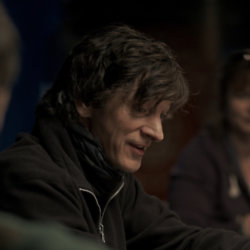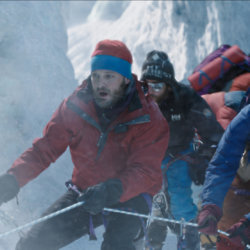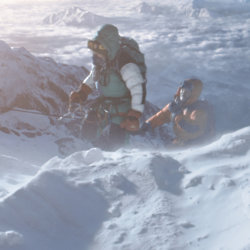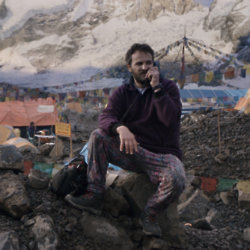Everest is set to hit the big screen this week and is one of the autumn movies that's not to be missed. Directed by Baltasar Kormákur, Everest charts the disaster on the mountain back in 1996.
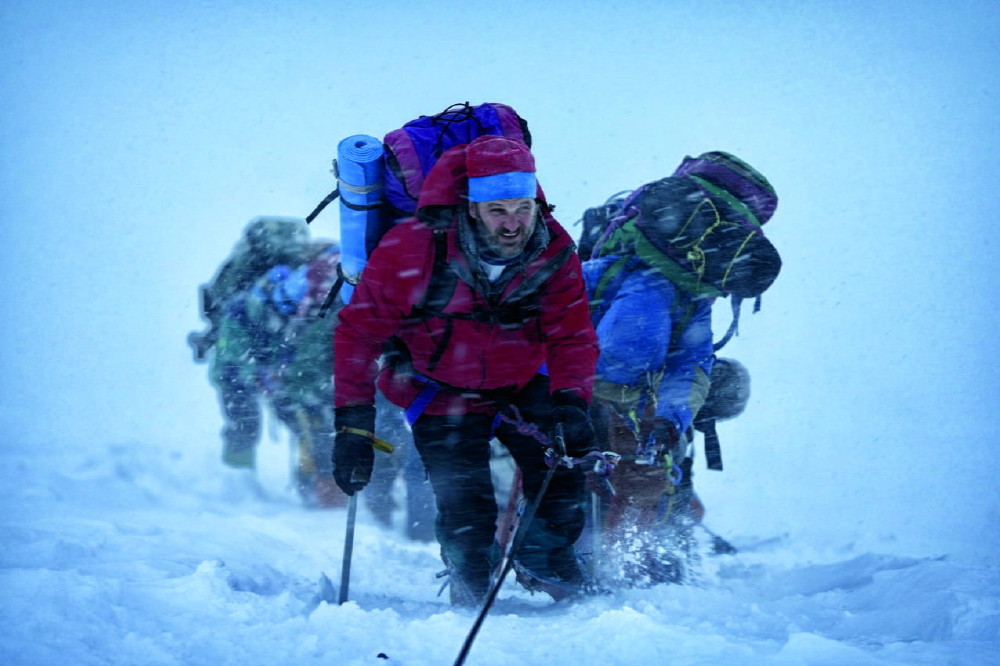
Everest
Mountaineer turned filmmaker David Breashears was on the mountain that day, shooting an IMAX movie, and has been brought on board the film project as a co-producer. David has a vast knowledge of Everest as well as first-hand experience of events of that day.
We caught up with him to chat about the film, where this project started for me, and what is it that draws him to the mountain.
- Everest is set to hit the big screen here in the UK next week, so can you tell me a bit about the film?
The film covers an incredible true-life story that occurred on Everest in 1996 during the spring climbing season, which is April and May. I was there working on an IMAX film as co-director and expedition leader. There were twelve teams gathered at basecamp that year, from many different nationalities and it was the beginning of the full-fledged guiding era on Everest. Everything was proceeding quite normally, carrying loads up the mountain and getting camps in place in fact, except for a couple of accidents that were not related to the weather, it was an uneventful year weather wise.
My team had gone up after we had acclimatised for four weeks on the mountain. We had gone up on our summit bid and we hadn't turned back because of the weather, but we had turned back from camp 3 because of wind; you cannot film with a 20KG IMAX camera in the wind. As we were going down, many other teams were heading up to the high camp at 26,000 feet. Two of the teams that are featured in the film are Rob Hall's Adventure Consultants team - Rob Hall is played by Jason Clarke and his wife is played by Keira Knightley - and the other team was the Mountain Madness team and their leader was Scott Fischer, who is played by Jake Gyllenhaal. They had decided to join forces in a bid to make fixing ropes more efficient and quicker but the exact opposite happened and there was confusion over who had which responsibilities, the day went long, oxygen supplies were low and they reached the summit late; especially Rob Hall, who had made it to the summit after 4pm with his client Doug Hansen.
Everyone was weary as they were starting back down the mountain and that is a time when you are very vulnerable - I have climbed Everest five times and you exert all this energy into reaching the summit and you need a fair amount to get down. You also invest a lot of your emotions and drive to reach the summit but it is not the finish line; the finish line is at the bottom. So they are heading down and at this moment of great vulnerability, sleep deprived, maybe somewhat hypoxic/oxygen deprived because they had run out of bottled oxygen, dehydrated, cold, and profoundly weary and, at this moment, a storm that no one could have predicted came rushing up the valley. Gaining force and energy the storm swept over the mountain - especially the upper mountain - in about half an hour. I know this because I was there looking at a blue sky at about 4.30pm and, half an hour later, there was the most violent storm that I have ever heard on the upper slopes of Everest.
The winds were sixty or seventy miles per hour, it was -30 or -40 degrees, and it was a dark storm with thunder and lightning and blowing snow. What compounded everything and made it all the more fearsome, was the fact that it got dark. The film is largely about the team that got to that point and then how it all ended with five people dead on the mountain and one who would lose his nose and most of his hands to frostbite.
- You served as co-producer on the film, so where did this project start for you and how did you get on board?
I had first climbed on Everest in 1981, when I was twenty five years old and I first filmed on its summit in 1983, when I made the first live broadcast. At that time, I was only the 136th person to climb Everest but I did go on to climb it again in 1985. The reason I was there in 1996 was to film and IMAX film and to lead the expedition to shoot the film. I was quite familiar with the mountain, its terrain, how to make films on the mountain, and I knew many of the characters that would play out in the film's narrative.
In 2002, Tim Bevan, who works for Working Title Films, contacted me and they knew that Universal had an option on some part of the story. At that point in development, they wanted to know something about the experience of what it was like up there, what it is like in a storm, what it is like not in a storm, basecamp life, the approach march, and they wanted to know about the characters; at the time, it was a little early to be talking to the people who had survived that storm themselves.
We began this thirteen year relationship with me serving as a consultant, one of two co-producers, and I almost served as an Everest cinematographer on one expedition to shoot on the mountain. Over the years, the film gained a better script, a better story, moved closer to the original story, until Tim and others at Working Title and Universal felt they had the story that they wanted. Then they started to put together this team. My involvement in this production is directly linked to my being on the mountain in 1996.
- A section of the film is shot on location on the mountain can you talk a bit about your role during that time of the shoot?
There were two times that we shot on the mountain; I led a team for Working Title and Universal from basecamp to the summit in 2004. At that time, we wanted to get all of the proper background imagery, use doubles, and made sure that this film looked authentic and made it look like we were on Mount Everest; we were, we climbed to the summit. We lost funding and we lost the director - that is a different story - but the film lurched along because of Tim Bevan's commitment to this project.
When we began shooting in January 2014, we took the team to a day's walk from the base of Everest at 16,000ft and we followed most of the route that a trekker follows to get within one day of basecamp. We had not intended to shoot in January because it is cold, the lodges are not heated, and your water bottles freeze in your room at night. It was very challenging for the crew to suddenly be put into this environment because we also moved the team, not only on foot and by helicopter, as high and as fast as the rules of acclimatisation would allow.
We really benefitted from that experience because by getting up that high quite quickly, the actors, the crew, and the director experienced what it was like to feel the effects of altitude, to see the mountain, to be around Sherpa culture, and that was of great value to the team as our first shoot, bonding together and becoming close to the Sherpas - eleven of who we later brought on the production to Italy and to London. The logistics of that and moving people up to an elevation of 16,000 feet in temperature of -10 and -20 degrees, was a challenge to everyone and the crew performed quite admirably.
From there, we moved right into the high mountains of Northern Italy and we hit the bullseye for landing in the middle of the worst and snowiest weather in one hundred year. Instead of having this nice mountain where it was going to be sunny at times and matched a lot of the light we had on Everest, we ended up on a mountain that saw eleven feet of snow fall while we were there. This really added to the film in the end because we went out of our lodges, up into the high mountain slopes for eight/ten/eleven hours a day in sometime ankle deep, sometimes knee deep, and sometime thigh deep snow (laughs).
The snow was so deep that half of the ski area that we were working in was sometimes closed because of avalanche danger. It was a remarkable performance for a film team. I have been on Everest fifteen times and filmed eleven times to the summit and these were Everest like conditions; we had everything except the thin air and more snow than you would ever get on Everest. Instead of just filming the sunny and nice moments on the mountain, we were filming in a blizzard. After that, it all got a lot easier in Rome and then in Pinewood.
What makes this film so compelling and authentic for me, is that how real the film seems to me - a person who has been on the mountain so much - and how authentic the characters are; it almost feels like a documentary at times. I think that a lot of that came from not only the fierce commitment by the director, Tim Bevan, and the actors to honouring the story and respecting it, but to the fact that in the first months of the production we were filming in real-life and extreme mountain conditions.
- You are no stranger to Everest - becoming the first American to reach the summit more than once and you have climbed the mountain on multiple occasions - so what is it about the mountain that intrigues you so much?
It intrigued me as an eleven year old boy, living in Wyoming, when I opened a book about mountains that had a picture of Tenzing Norgay on the summit on May 29th, 1953. My boy's mind thought that there was no higher aspiration than a person could have then to be a mountaineer. So I became a mountaineer long before I became a filmmaker; that was a natural part of the journey of a mountaineer, at least one that was interested in the Himalayas, as I was.
It is not always the allure of Everest, I like being on the mountain, I like the people of Nepal - in fact, the Sherpas are like family members to me. So it is a combination of the experience of passing through these villages, meeting people who you have come to know and love, the challenges on the mountain, but also the friendships that are born in hardship and strife that are as valuable to me as any time that I have stood on the summit.
- Finally, what's next for you going through the rest of this year - have got any more climbs, films of books in the pipeline?
I will be back in Nepal or somewhere in the Himalayas because, for most of the past nine years, I have focused on documenting climate change - I also have my own non-profit company glacierworks.org. It is very important to me because I love this region and these people so deeply, to help them understand the consequences of climate change and how they can adapt to it.
I tend to go two or three times a year and the Fall season is a good one as there are clear skies and nice weather. I haven't put my finger to a point on the map yet, but I will be somewhere in Nepal in October and November.
Everest is released 18th September.


